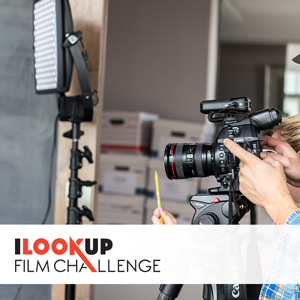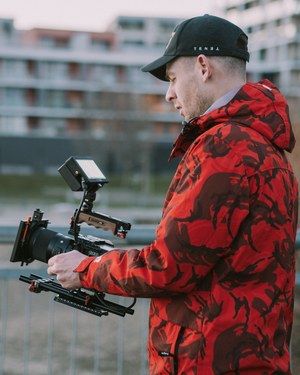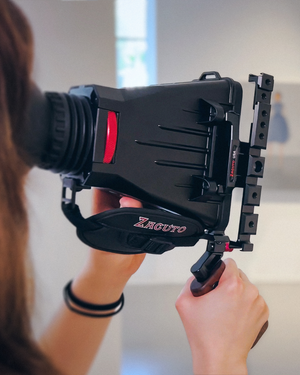
The Art of Architecture Films - Q&A with Riley Engemoen
Architecture can be so much more than just a beautiful backdrop. For architects, so much of design is about the actual people impacted. They want people to know that behind every building is a human story -- which leaves a wealth of stories for filmmakers to showcase!
When tasked with creating an example documentary short for our AIA-sponsored I Look Up Film Challenge, we wanted to highlight a community that experienced huge impact by collaborating with a fabulous architecture firm. Like every great story, this short is about people, which brings the architecture alive.
We did a Q&A with our filmmaker, Riley Engemoen, to discuss what makes a great architecture documentary, and to pick his brain for documentary filmmaking wisdom. Read on, then take the challenge!
 What lenses do you bring to a shoot like this?
I shoot mainly with a 24mm‑105mm ‑ F/4.0 because it’s great glass and is very versatile. You can be wide and then zoom in for a match action cut. It’s a super solid documentary lens.
What are your visual storytelling must-haves when going into a shoot?
I love shooting kids playing. If I can find a way to bring that into a section of the film I always do. It’s always great to shoot during golden hour. And most importantly be ready to go with the flow and change direction when on a doc shoot. Be ready to “steal” a shot in an instant when something great happens.
For you, what this an architecture piece or a social awareness piece?
The architecture was definitely a big centerpoint in this project, but I love to hone in on the subtleties of the people themselves. I think the intonation or energy in a spoken line can often be more powerful than the words themselves.
How do you bring the best out in characters when on a shoot like this, in a place you’re not from?
The more time you can spend with somebody the better. If you have any time at all to spend with the characters outside of filming, you get the chance to build a relationship with them. If they feel comfortable with you, you’re able to get a sincere version of them on camera. You can’t force the moment. You have to have real conversations with people.
What lenses do you bring to a shoot like this?
I shoot mainly with a 24mm‑105mm ‑ F/4.0 because it’s great glass and is very versatile. You can be wide and then zoom in for a match action cut. It’s a super solid documentary lens.
What are your visual storytelling must-haves when going into a shoot?
I love shooting kids playing. If I can find a way to bring that into a section of the film I always do. It’s always great to shoot during golden hour. And most importantly be ready to go with the flow and change direction when on a doc shoot. Be ready to “steal” a shot in an instant when something great happens.
For you, what this an architecture piece or a social awareness piece?
The architecture was definitely a big centerpoint in this project, but I love to hone in on the subtleties of the people themselves. I think the intonation or energy in a spoken line can often be more powerful than the words themselves.
How do you bring the best out in characters when on a shoot like this, in a place you’re not from?
The more time you can spend with somebody the better. If you have any time at all to spend with the characters outside of filming, you get the chance to build a relationship with them. If they feel comfortable with you, you’re able to get a sincere version of them on camera. You can’t force the moment. You have to have real conversations with people.
 What moments were you anticipating that you prepared for ahead of time, and what was spur-of-the-moment?
We scheduled most of the interviews before hand, but all the b-roll was captured in the moment. I would see something beautiful and try to respectfully approach the situation, explain what I was filming for, and capture it.
Did any special moments need to be cut from the Midtown piece? How did you make the decision to cut it?
We got some amazing footage of Jim Powell, 76, riding his bike through the forest that was really beautiful but just didn’t fit in with the story. We were trying to tell of the neighborhood so we had to cut it.
What kind of look were you going for overall, and how did you achieve this?
Visually, I wanted an earnest handheld quality with natural color, not overly saturated or desaturated, as to keep the focus on the people and the community instead of overdoing it with color or look.
And for sound?
Music is very important to the feel of a film. Jackson resident, Tyler Tadlock, provided music for the score. I also always capture live audio with every visual shot to ground it and give it a certain realness.
What other advice do you have for filmmakers participating in the I Look Up film challenge?
You have to really dive in and reach out to people to get the most out of any situation. But understand that your characters are in a vulnerable state in front of the lens. Make friends with your documentary subjects. Share yourself with them. Documentary is a great way to learn and to see the world! Have fun!
What moments were you anticipating that you prepared for ahead of time, and what was spur-of-the-moment?
We scheduled most of the interviews before hand, but all the b-roll was captured in the moment. I would see something beautiful and try to respectfully approach the situation, explain what I was filming for, and capture it.
Did any special moments need to be cut from the Midtown piece? How did you make the decision to cut it?
We got some amazing footage of Jim Powell, 76, riding his bike through the forest that was really beautiful but just didn’t fit in with the story. We were trying to tell of the neighborhood so we had to cut it.
What kind of look were you going for overall, and how did you achieve this?
Visually, I wanted an earnest handheld quality with natural color, not overly saturated or desaturated, as to keep the focus on the people and the community instead of overdoing it with color or look.
And for sound?
Music is very important to the feel of a film. Jackson resident, Tyler Tadlock, provided music for the score. I also always capture live audio with every visual shot to ground it and give it a certain realness.
What other advice do you have for filmmakers participating in the I Look Up film challenge?
You have to really dive in and reach out to people to get the most out of any situation. But understand that your characters are in a vulnerable state in front of the lens. Make friends with your documentary subjects. Share yourself with them. Documentary is a great way to learn and to see the world! Have fun!


Q&A with Riley Engemoen
What’s your run-and-gun setup for a shoot like this? Riley Engemoen: I shot the Midtown doc mostly handheld with a Canon C100 Mark II and a 24mm‑105mm ‑ F/4.0. I’ll shoot talking heads or longer scenes on tripod but for run-and-gun I go handheld but try to stay as stable and controlled as possible. A good rule of thumb is to hold every shot stable for at least 7 seconds and consider all movement as potentially being usable. Be steady. What lenses do you bring to a shoot like this?
I shoot mainly with a 24mm‑105mm ‑ F/4.0 because it’s great glass and is very versatile. You can be wide and then zoom in for a match action cut. It’s a super solid documentary lens.
What are your visual storytelling must-haves when going into a shoot?
I love shooting kids playing. If I can find a way to bring that into a section of the film I always do. It’s always great to shoot during golden hour. And most importantly be ready to go with the flow and change direction when on a doc shoot. Be ready to “steal” a shot in an instant when something great happens.
For you, what this an architecture piece or a social awareness piece?
The architecture was definitely a big centerpoint in this project, but I love to hone in on the subtleties of the people themselves. I think the intonation or energy in a spoken line can often be more powerful than the words themselves.
How do you bring the best out in characters when on a shoot like this, in a place you’re not from?
The more time you can spend with somebody the better. If you have any time at all to spend with the characters outside of filming, you get the chance to build a relationship with them. If they feel comfortable with you, you’re able to get a sincere version of them on camera. You can’t force the moment. You have to have real conversations with people.
What lenses do you bring to a shoot like this?
I shoot mainly with a 24mm‑105mm ‑ F/4.0 because it’s great glass and is very versatile. You can be wide and then zoom in for a match action cut. It’s a super solid documentary lens.
What are your visual storytelling must-haves when going into a shoot?
I love shooting kids playing. If I can find a way to bring that into a section of the film I always do. It’s always great to shoot during golden hour. And most importantly be ready to go with the flow and change direction when on a doc shoot. Be ready to “steal” a shot in an instant when something great happens.
For you, what this an architecture piece or a social awareness piece?
The architecture was definitely a big centerpoint in this project, but I love to hone in on the subtleties of the people themselves. I think the intonation or energy in a spoken line can often be more powerful than the words themselves.
How do you bring the best out in characters when on a shoot like this, in a place you’re not from?
The more time you can spend with somebody the better. If you have any time at all to spend with the characters outside of filming, you get the chance to build a relationship with them. If they feel comfortable with you, you’re able to get a sincere version of them on camera. You can’t force the moment. You have to have real conversations with people.
 What moments were you anticipating that you prepared for ahead of time, and what was spur-of-the-moment?
We scheduled most of the interviews before hand, but all the b-roll was captured in the moment. I would see something beautiful and try to respectfully approach the situation, explain what I was filming for, and capture it.
Did any special moments need to be cut from the Midtown piece? How did you make the decision to cut it?
We got some amazing footage of Jim Powell, 76, riding his bike through the forest that was really beautiful but just didn’t fit in with the story. We were trying to tell of the neighborhood so we had to cut it.
What kind of look were you going for overall, and how did you achieve this?
Visually, I wanted an earnest handheld quality with natural color, not overly saturated or desaturated, as to keep the focus on the people and the community instead of overdoing it with color or look.
And for sound?
Music is very important to the feel of a film. Jackson resident, Tyler Tadlock, provided music for the score. I also always capture live audio with every visual shot to ground it and give it a certain realness.
What other advice do you have for filmmakers participating in the I Look Up film challenge?
You have to really dive in and reach out to people to get the most out of any situation. But understand that your characters are in a vulnerable state in front of the lens. Make friends with your documentary subjects. Share yourself with them. Documentary is a great way to learn and to see the world! Have fun!
What moments were you anticipating that you prepared for ahead of time, and what was spur-of-the-moment?
We scheduled most of the interviews before hand, but all the b-roll was captured in the moment. I would see something beautiful and try to respectfully approach the situation, explain what I was filming for, and capture it.
Did any special moments need to be cut from the Midtown piece? How did you make the decision to cut it?
We got some amazing footage of Jim Powell, 76, riding his bike through the forest that was really beautiful but just didn’t fit in with the story. We were trying to tell of the neighborhood so we had to cut it.
What kind of look were you going for overall, and how did you achieve this?
Visually, I wanted an earnest handheld quality with natural color, not overly saturated or desaturated, as to keep the focus on the people and the community instead of overdoing it with color or look.
And for sound?
Music is very important to the feel of a film. Jackson resident, Tyler Tadlock, provided music for the score. I also always capture live audio with every visual shot to ground it and give it a certain realness.
What other advice do you have for filmmakers participating in the I Look Up film challenge?
You have to really dive in and reach out to people to get the most out of any situation. But understand that your characters are in a vulnerable state in front of the lens. Make friends with your documentary subjects. Share yourself with them. Documentary is a great way to learn and to see the world! Have fun!
Have a Story to Tell? Win Prizes!
Tell your story about a Blueprint for Better. Join the I Look Up Film Challenge today! Submissions due August 13th, 2017 at ilookup.org The American Institute of Architect’s third annual I Look Up Film Challenge invites architects and filmmakers to collaborate in bringing architectural stories to life. This year’s challenge calls for films that highlight projects and architects that are helping to change communities for the better. Click to expand.



Leave a comment